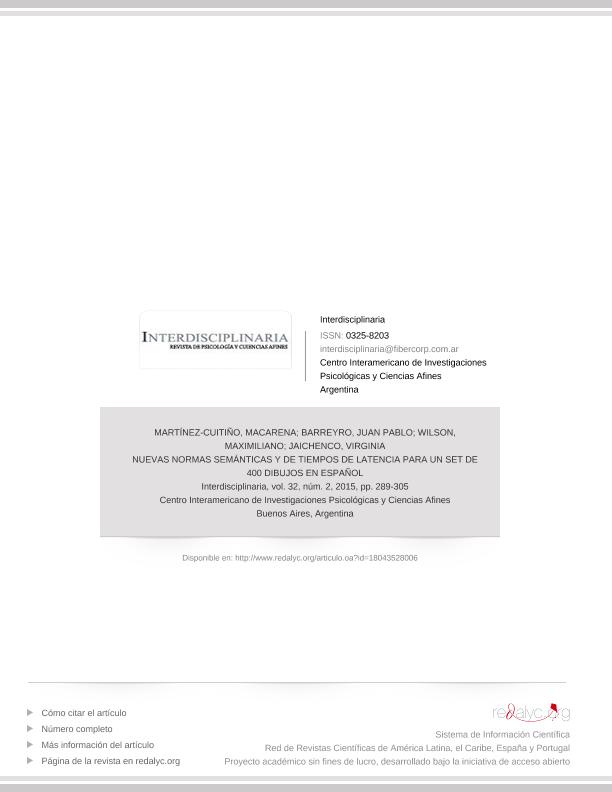Artículo
La utilización de estímulos pictóricos en la investigación básica y clínica dejó de manifiesto la necesidad de disponer de material con normas pictóricas, lingüísticas y semánticas adecuadas a cada población. El objetivo del presente trabajo es el de presentar, para el set de 400 estímulos desarrollados por Cycowicz, Friedamn, Tothstein y Snodgrass (1997), los tiempos de latencia obtenidos a partir de una tarea de denominación con tiempos de reacción. Asimismo se obtuvieron nuevas normas léxico-semánticas para el set de estímulos a fin de ampliar los datos previamente recolectados por Manoiloff y cols. (2010). Se recabaron datos de las variables de frecuencia léxica subjetiva, imaginabilidad, concretud, familiaridad conceptual, familiaridad visual, familiaridad funcional, tipicalidad, idea asociada y categoría semántica. Por último se compararon los estímulos pertenecientes a los dominios de seres vivos y objetos inanimados a fin de identificar posibles diferencias entre las principales variables léxico-semánticas. Se espera que estos datos sean útiles para la selección de estímulos adecuados tanto para la práctica clínica diaria como para futuras investigaciones. Many parameters such as visual recognition, access to the concept or recovery the phonological format of a word influence different stages of the oral naming. Basic and clinical research showed the requirement of using the same pictorial stimuli for each culture. Nevertheless, pictorial stimuli may vary in visual complexity, image agreement, etc., semantic (conceptual familiarity, age of ac - qui sition, image ability, concreteness, etc.) and linguistic norms (naming agreement, lexical fre - quency) in each different culture. Adaptation and standardization of pictorial stimuli are a critical issue since they are useful in research with healthy subjects (Psycholinguistic and Cognitive Psychol - ogy) as well as in studies of patients with acquired brain injuries (Neuropsychology and Neuro lin - guistic). In recent years, many researchers developed and adapted their own set to their socio-linguistic environment. However, the variability in the stimuli used makes difficult the comparison of the results reached (Alario & Ferrand, 1999). Snod - grass and Vanderwart (1980) developed the first corpus of pictorial stimuli. This corpus is com pos ed by 260 drawings in black and white and they are standardized according to four variables: name agreement, image agreement, conceptual familiar ity and visual complexity. have obtained certain variables for the pictorial stimuli developed by Manoiloff, Artstein, Canavoso, Fernández, & Se - guí (2010) Cycowicz, Friedamn, Tothstein, & Snodgrass (1997) for our population. The material includes Snodgrass and Vanderwart’s pictorial set (1980). They recollected data from seven variables: name agreement, image agreement, visual complexity, conceptual familiarity, image variability, age of acquisition and associated word. In this study we have three aims. The first one is to expand the normative data obtained by Manoiloff and colaborators (2010) by adding other lexicalsemantic variables of importance in cognitive processing variables. In this study we included the subjective lexical frequency, image ability, con cret eness, conceptual, visual and functional familiarity, typicality and semantic category. Second, we aim to obtain naming agreement (H and %NA) with a reaction time paradigm in order to compare our results with those obtained by Manoiloff and colaborators (2010). To administrate the task DM DX Program (Forster, K.I. & Forster, J.C., 2003) was used and all the responses were checked and classified using Check Vocal (Proto papas, 2007). The naming agreement of our population (H and %NA) was compared with the dates obtained by Manoiloff and colaborators (2010). Latency times were compared with the latency time for Spain (Cue tos, Ellis, & Alvarez, 1999). Spanish participants require less time to activate pictures names. This difference may be product of the design of the task, the stimuli used or because possible differences in the samples evaluated. Finally, taking in account that Bunn, Tyler, and Moss (1998) have reported that in the Snodgrass and Vanderwart´s pictures set (1980) the living things have less familiarity that in - animate objects, we compare the main semantic domains (living things and inanimate objects) in the most important lexical and semantic variables: visual complexity, conceptual familiarity, subjec - tive lexical frequency, image ability, etc. In the data we obtained from the name agreement variable: H and %NA indexes (H and %NA). Both variables differ from Manoiloff´s data. When participants have a restricted time in oral naming, as in this study, they answered with less precision, thus obtaining higher values in H. The same result was observed when comparing the %NA. The outcomes show that this stimuli set has high image ability, concreteness and familiarity. Moreover, these results show that living things require more time for oral naming. The words that represent inanimate objects have more lexical frequency, are more familiar visually and tionally and also have more conceptual familiarity. In the concreteness variable the inanimate objects are more concrete than living things. And in the image ability variable, living things and inanimate objects are similar. These variables are also high correlated.
Nuevas normas semánticas y de acuerdo en el nombre para un set de 400 dibujos en español
Título:
New semantic and latency times norms for a 400 pictures set in spanish
Martínez Cuitiño Carricaburo, María Macarena ; Barreyro, Juan Pablo
; Barreyro, Juan Pablo ; Wilson, Maximiliano; Jaichenco, Virginia Irene
; Wilson, Maximiliano; Jaichenco, Virginia Irene
 ; Barreyro, Juan Pablo
; Barreyro, Juan Pablo ; Wilson, Maximiliano; Jaichenco, Virginia Irene
; Wilson, Maximiliano; Jaichenco, Virginia Irene
Fecha de publicación:
10/2015
Editorial:
Centro Interamericano de Investigaciones Psicológicas y Ciencias Afines
Revista:
Interdisciplinaria
ISSN:
0325-8203
Idioma:
Español
Tipo de recurso:
Artículo publicado
Clasificación temática:
Resumen
Palabras clave:
NORMAS
,
ESPAÑOL
,
DENOMINACIÓN
,
TIEMPOS DE LATENCIA
,
DIBUJOS
Archivos asociados
Licencia
Identificadores
Colecciones
Articulos(SEDE CENTRAL)
Articulos de SEDE CENTRAL
Articulos de SEDE CENTRAL
Citación
Martínez Cuitiño Carricaburo, María Macarena; Barreyro, Juan Pablo; Wilson, Maximiliano; Jaichenco, Virginia Irene; Nuevas normas semánticas y de acuerdo en el nombre para un set de 400 dibujos en español; Centro Interamericano de Investigaciones Psicológicas y Ciencias Afines; Interdisciplinaria; 32; 10-2015; 289-305
Compartir



